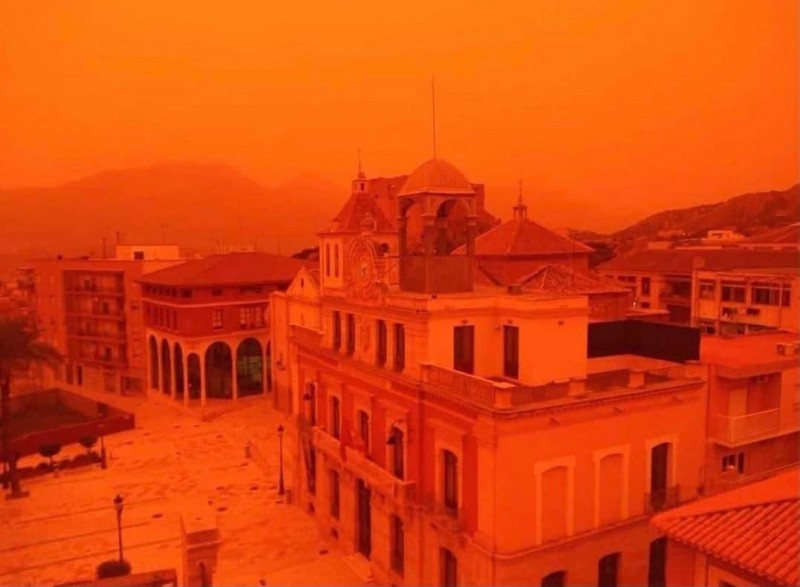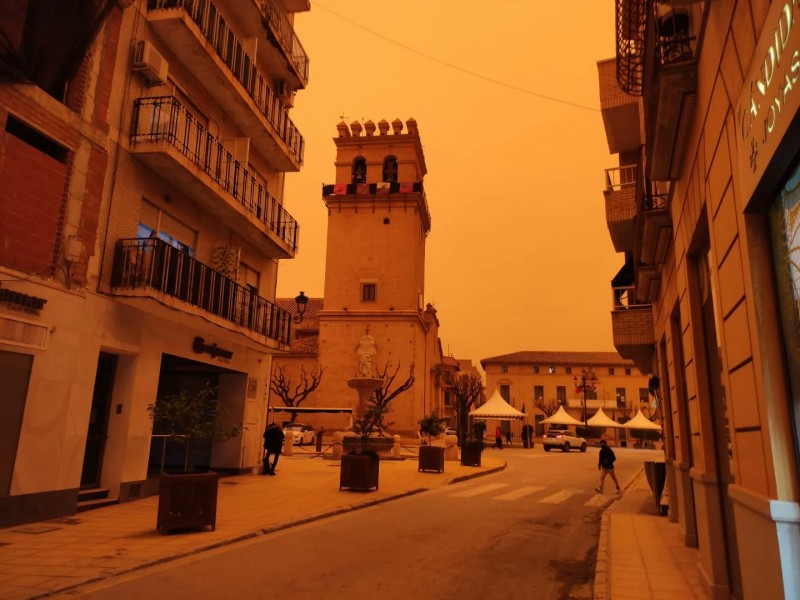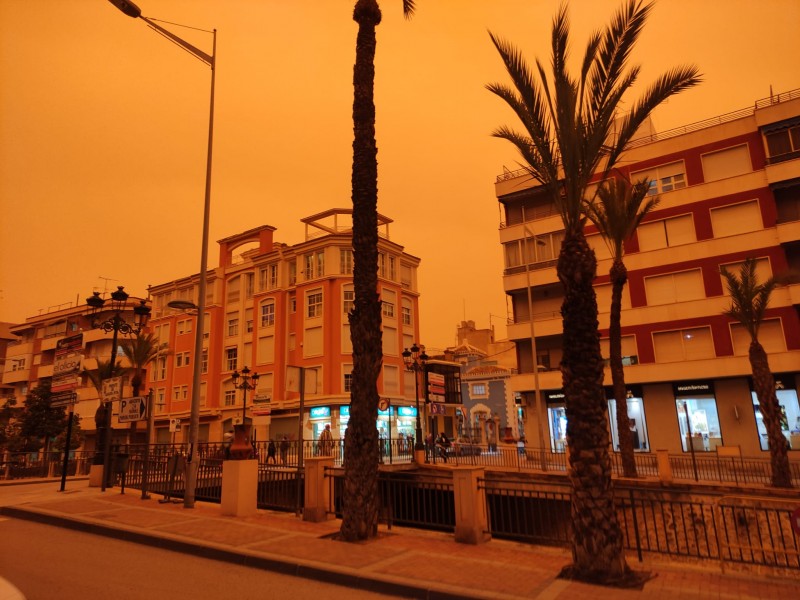Date Published: 15/03/2022
ARCHIVED - Why is the sky orange, how long will it last and is it dangerous?
Answers to all your questions about the red Saharan dust over Murcia and Alicante this week

Storm Celia has left almost apocalyptic images in the Region of Murcia and in Alicante after the sky was turned orange due to the large amount of dust brought over from the Sahara Desert.
The Saharan dust suspended in the air will continue at least until Thursday. Combined with the rainfall expected throughout the week, the dust will cause muddy rain and air quality is expected to decrease significantly.
Because of this, authorities are recommending that people use FFP2 masks when they go outside to avoid getting dust particles in their lungs. These masks are no longer mandatory outdoors to protect against Covid-19, of course, but it turns out they’re handy to have for other reasons. This situation of extremely unfavourable levels of air quality is expected to be last at least for Monday and Tuesday of this week, and possibly longer.
What causes Saharan dust in Spain and why does it make the sky orange?
Social media has filled up with images of Spain looking like the surface of Mars with dramatic orange skies because of the Saharan dust, but why does it come over from Africa and what makes it hang around for so long?
The dust is carried over on air masses from the south, and has been responsible for the haze that has settled over Murcia and Alicante. This is to blame for the decrease in visibility due to the presence of dry particles, which cause orange tones.
 Actually, not all of it comes from the desert. The dust can have multiple sources – it can come from the soil, smoke from forest fires, industrial emissions, salt spray, volcanic eruptions and even organic matter such as bacteria, pollen and animal hairs. But for brevity’s sake we’ll just call it dust.
Actually, not all of it comes from the desert. The dust can have multiple sources – it can come from the soil, smoke from forest fires, industrial emissions, salt spray, volcanic eruptions and even organic matter such as bacteria, pollen and animal hairs. But for brevity’s sake we’ll just call it dust.When the rains wash the dust to the surface, it produces the dreaded ‘muddy rain’, also called ‘dust rain’ or ‘red rain’, which leaves everything in its path covered in a fine layer of sandy, red dust. Get ready to go to the carwash when this is all over.
Weather experts are calling the orange sky an “exceptional” episode as this phenomenon has not occurred with this intensity for several decades.
As the president of the Association of Spanish Geographers (AGE), Professor Jorge Olcina of the University of Alicante (UA), put it: This is “an arrival of Saharan dust such as has not been recorded in Spain for decades.”
Where will the dust go next?
Professor Olcina says that the extraordinary weather front is heading from south to north through the east of the country: “The Saharan dust is taking advantage of the eastern side of the DANA that has formed in the Gulf of Cádiz to ascend from the Sahara Desert to western Europe.”
The extreme weather front has already left intermittent power cuts in some parts of Alicante province, and the Saharan dust can also cause and exacerbate health conditions.
Is the Saharan dust dangerous?
These particles of red dust do have negative effects on health and can cause respiratory and cardiac  problems if breathed in. It can cuase symptoms like coughing, nasal obstruction and itchy eyes. If the phenomenon is persistent, bronchospasm, chest pain and asthma may occur, especially in people with allergies.
problems if breathed in. It can cuase symptoms like coughing, nasal obstruction and itchy eyes. If the phenomenon is persistent, bronchospasm, chest pain and asthma may occur, especially in people with allergies.
 problems if breathed in. It can cuase symptoms like coughing, nasal obstruction and itchy eyes. If the phenomenon is persistent, bronchospasm, chest pain and asthma may occur, especially in people with allergies.
problems if breathed in. It can cuase symptoms like coughing, nasal obstruction and itchy eyes. If the phenomenon is persistent, bronchospasm, chest pain and asthma may occur, especially in people with allergies.Air quality is being measured hourly, and there are PM10 peaks of almost 400, more than 300 and 70 micrograms per cubic metre of air in Lorca, Cartagena and Murcia capital.
To put this into context, to activate the first, lowest pollution alert level, air quality has to be at a maximum daily average of 50. For the intermediate alert level it’s 80 and for the maximum it’s 100. Now we’re seeing almost 400.
Here’s what you can do to protect yourself against the dangerously low air quality
In addition to using FFP2 masks to protect the respiratory tract, it is advisable to reduce car emissions by driving less, which will avoid a further worsening of air quality.
Avoid physical activities and intense sports, both outdoors and indoors. This is especially important for people with existing respiratory problems. Only go out for short periods if absolutely necessary.
In the event of breathing difficulties or cardiac discomfort (wheezing, palpitations), consult a health professional.
Avoid travelling on and around main roads during the periods when there is usually more traffic (generally early in the morning and late in the afternoon, at rush hour) because this is when the air quality is at its worst.
>>> Get more weather insights about Murcia here or join our Facebook groups: Murcia Weather Watch and Alicante Weather Watch <<<
Image 1: Ayuntamiento de Mazarrón
Images 2 & 3: Ayuntamiento de Totana
Loading
Sign up for the Spanish News Today Editors Roundup Weekly Bulletin and get an email with all the week’s news straight to your inbox
Special offer: Subscribe now for 25% off (36.95 euros for 48 Bulletins)
OR
you can sign up to our FREE weekly roundup!
Read some of our recent bulletins:
Discount Special Offer subscription:
36.95€ for 48 Editor’s Weekly News Roundup bulletins!
Please CLICK THE BUTTON to subscribe.
(List price 3 months 12 Bulletins)
Read more stories from around Spain:
Contact Spanish News Today: Editorial 966 260 896 /
Office 968 018 268




































